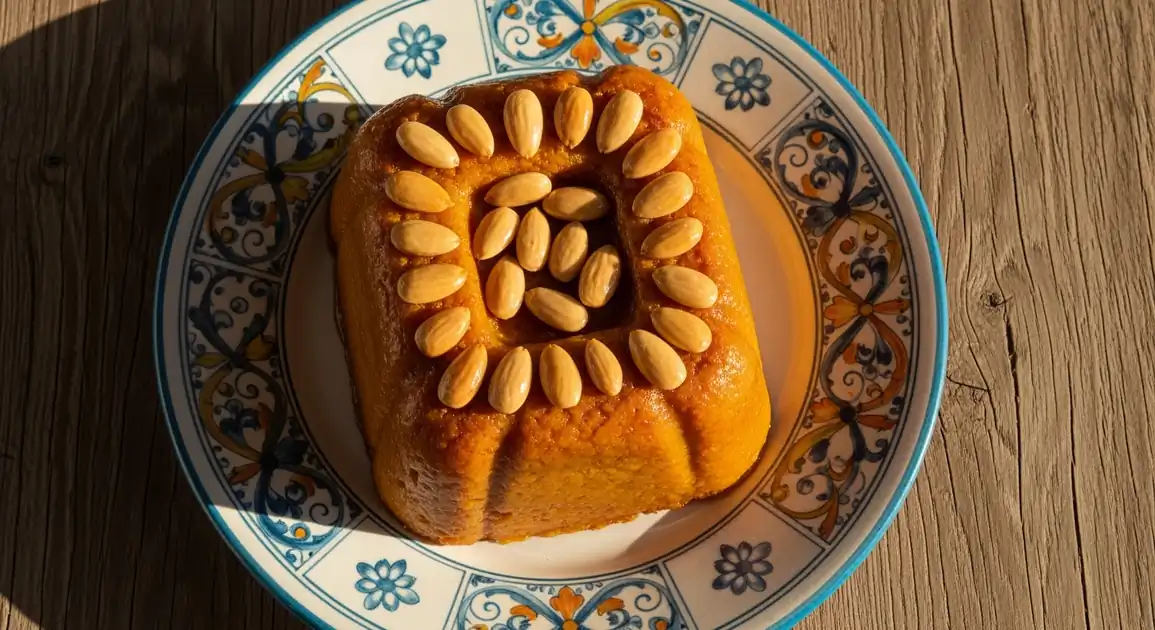Arnadi
Arnadí

Description
Valencia, as the heart of the Comunidad Valenciana, is where Arnadi (or Arnadí in Valencian) reaches its finest expression. In this coastal Mediterranean city, the dessert maintains its traditional preparation while benefiting from the region's exceptional almonds and locally grown pumpkin varieties. Here, Arnadi is both a year-round treat at quality bakeries and a cultural symbol during regional celebrations.
Dietary Information
Serving information
Serving style
In bakeries, served on small plates or wrapped in paper. In restaurants, sometimes presented with decorative elements like mint leaves or a light dusting of powdered sugar.
Quick facts
Traditional bakeries: 8 AM - 2 PM and 5 PM - 8 PM, often closed Sunday afternoons and Monday mornings. Restaurants serving Arnadi as dessert: Lunch 1:30 PM - 4 PM, Dinner 8:30 PM - 11:30 PM.
Safety Tips
What to Look For
-
Natural, consistent light orange-yellow color
The natural color from pumpkin should be even and not overly bright or artificial-looking, indicating quality ingredients and proper preparation.
-
Freshly made with no signs of drying out or cracking
Quality Arnadi should have a smooth, moist texture. Cracks or dry edges suggest it's been stored too long.
-
Made in small batches rather than mass-produced
Artisanal bakeries making limited quantities tend to maintain higher quality and traditional methods.
-
Clean, well-maintained display cases with proper temperature control
Arnadi contains eggs and should be kept in refrigerated or cool conditions, especially in warmer months.
What to avoid
-
Bright orange or yellow artificial coloring
Authentic Arnadi has a natural, subtle color from real pumpkin. Vivid coloring indicates artificial additives.
-
Pre-packaged versions with long shelf life
Traditional Arnadi has limited preservatives and should be relatively fresh. Long shelf-life versions typically contain additives.
-
Overly wet or soggy texture
Proper Arnadi has a firm, flan-like consistency. Excessive moisture indicates poor preparation or quality issues.
-
Refrigerated items displayed next to unrefrigerated ones
Cross-contamination risks increase in places with poor food storage practices.
Price information
Price range
Budget tips
- Traditional neighborhood bakeries in residential areas like Russafa or Benimaclet offer better value (2.50-4 EUR) than those in the touristy old town.
- During the week of Valencia Day (October 9), many bakeries offer special deals on traditional sweets including Arnadi.
- Some establishments offer a café con postre (coffee with dessert) deal that includes Arnadi at a discount.
- Markets like Mercado de Colón or Mercado Central may have slightly better prices than standalone pastry shops.
Value indicators
- Hand-shaped with visible craftsmanship rather than uniform, mass-produced appearance.
- Made with local Valencian pumpkin varieties like calabaza totanera.
- Proper balance of ingredients showing both pumpkin and almond flavors.
- Fresh rather than pre-packaged or several days old.
- Correct semi-firm consistency rather than overly soft or dry.
Where to Find This Dish
El Carmen (Old Town)
Historic bakeries in the ancient core of Valencia specializing in traditional Valencian pastries.
Plaza de la Virgen, Torres de Serranos, Valencia Cathedral
Morning, Afternoon
Russafa
This trendy neighborhood has both traditional bakeries and modern patisseries with creative takes on Arnadi.
Mercado de Russafa, Plaza del Doctor Landete
Morning, Afternoon
Mercado Central
Valencia's spectacular central market contains specialty pastry stalls selling traditional sweets.
La Lonja de la Seda, Plaza del Mercado
Morning (8 AM - 2 PM)
L'Eixample
Upscale neighborhood with fine pastry shops catering to discerning customers.
Colón Market, Calle Colón
Morning, Afternoon
Vendor Tips
- Look for the sign 'Pastisseria Valenciana' (Valencian pastry shop) for more authentic preparations.
- Ask for 'Arnadí casolà' or 'Arnadí artesanal' for homemade or artisanal versions.
- Check if they make it on-site rather than bringing it in from mass producers.
- Morning visits often yield the freshest products at bakeries.
How to Order
Regional Variations
-
Modern Arnadi
(Arnadí Moderno)
Some innovative pastry shops in Valencia city offer contemporary versions with additions like orange confit, chocolate accents, or pistachio garnishes.
-
Valencia City Style
(Arnadí Estilo Valencia)
The city version tends to be more refined and uniform in presentation than rustic versions from surrounding villages.
-
Restaurant Arnadi
(Arnadí de Restaurante)
Restaurant versions often feature more elaborate plating, perhaps with complementary elements like citrus segments or a drizzle of honey.
Cultural context
History
Arnadi dates back to Moorish times in Spain (8th-15th centuries), reflecting the Arab influence on Valencian cuisine with its use of almonds and sweet pumpkin preparations. The dessert is particularly associated with the town of Xàtiva in Valencia province. Traditionally prepared for the feast of Sant Donís (October 9th), which coincides with Valencia Day celebrations, the dessert symbolizes the mountains of Valencia (particularly the Sierra de Aitana). It remains a treasured part of the region's pastry tradition, representing the blending of cultures that shaped Valencian identity.
Local significance
In Valencia, Arnadi is particularly associated with the celebration of October 9th (Día de la Comunidad Valenciana and Sant Donís), commemorating King James I's conquest of the city in 1238. It represents the sweet traditions of the region and the historical Moorish influence on Valencian cuisine.
Eating customs
- Often accompanied by a 'cortado' (espresso with a splash of milk) or 'café con leche' in the afternoon.
- In restaurants, sometimes served with a small glass of local Mistela wine.
- Traditionally eaten at room temperature to best appreciate the texture and flavor.